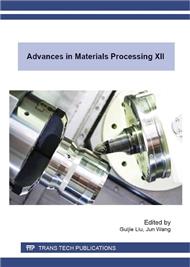[1]
P. Hubera, D. Manova, S. Mandl, B. Rauschenbach, Formation of TiN, TiC and TiCN by metal plasma immersion ion implantation and deposition, Surf. Coat. Technol. 174-175 (2003) 1243-1247.
DOI: 10.1016/s0257-8972(03)00458-4
Google Scholar
[2]
J. Soldan, J. Musil, Structure and mechanical properties of DC magnetron sputtered TiC/Cu films, Vacuum. 81 (2006) 531-538.
DOI: 10.1016/j.vacuum.2006.07.013
Google Scholar
[3]
M. Karbasi, M.R.Z. Ghavidel, A. Saidi, S. Sabooni, Comparison between tribological behaviour of HVOF coatings produced from conventional Ni+TiC powder mixture and Ni-TiC Ni-(Ti, W)C composite powders, Surf. Eng. 28 (2012) 155-163.
DOI: 10.1179/1743294411y.0000000081
Google Scholar
[4]
Z.X. Wang, Z.Y. He, Y.Q. Wang, X.P. Liu, B. Tang, Microstructure and tribological behaviors of Ti6Al4V alloy treated by plasma Ni alloying, Appl. Surf. Sci. 257 (2011) 10267-10272.
DOI: 10.1016/j.apsusc.2011.07.040
Google Scholar
[5]
Z. Xu, X. Liu, P. Zhang, Y. Zhang, G. Zhang, Z. He, Double glow plasma surface alloying and plasma nitriding, Surf. Coat. Technol. 201 (2007) 4822-4825.
DOI: 10.1016/j.surfcoat.2006.07.187
Google Scholar
[6]
X. Zhang, X.S. Xie, Z.M. Yang, J.X. Dong, Z. Xu, Y. Gao, T.H. Zhang, A study of nickel-based corrosion resisting alloy layer obtained by double glow plasma surface alloying technique, Surf. Coat. Technol. 131 (2000) 378-382.
DOI: 10.1016/s0257-8972(00)00818-5
Google Scholar
[7]
X. Jiang, X. Zhang, X.S. Xie, Z. Xu, W.J. Liu, Ni-based superalloy surface alloying by double-glow plasma surface alloying technique, Vacuum. 72 (2004) 489-500.
DOI: 10.1016/j.vacuum.2003.11.001
Google Scholar
[8]
J. Huang, P.Z. Zhang, H.Y. Wu, W.J. Bao, Investigation of W-Mo alloyed layer synthesised by double glow plasma surface metallurgy, Surf. Eng. 27 (2011) 113-117.
DOI: 10.1179/026708410x12506870724433
Google Scholar
[9]
Z.F. Chen, W.P. Wu, L.B. Wang, Y. Zhang, Microstructure and analytic equation of conical aggregate in iridium coating prepared by double glow plasma, Surf. Eng. 27 (2011) 242-245.
DOI: 10.1179/174329409x397787
Google Scholar
[10]
Z.H. Li, S.S. Liu, Z.Y. Chen, Study on plasma discharge parameters in double-glow plasma surface alloying furnace, Vacuum. 83 (2009) 801-804.
DOI: 10.1016/j.vacuum.2008.07.013
Google Scholar
[11]
W.B. Wang, Z. Xu, Z.Y. He, Z.X. Wang, P.Z. Zhang, Study on double-glow plasma niobium surface alloying of pure titanium, Vacuum. 81 (2007) 937-942.
DOI: 10.1016/j.vacuum.2006.09.008
Google Scholar
[12]
X.P. Liu, Y. Gao, Z.H. Li, Z. Xu, W.H. Tian, B. Tang, Cr-Ni-Mo-Co surface alloying layer formed by plasma surface alloying in pure iron, Appl. Surf. Sci. 252 (2006) 3894-3902.
DOI: 10.1016/j.apsusc.2005.06.001
Google Scholar
[13]
X.N. Cong, Z.F. Chen, W.P. Wu, J. Xu, F.E. Boafo, A novel Ir-Zr gradient coating prepared on Mo substrate by double glow plasma, Appl. Surf. Sci. 258 (2012) 5135-5140.
DOI: 10.1016/j.apsusc.2012.01.149
Google Scholar
[14]
J.Y. Xu, Y.P. Liu, J.Z. Wang, X.Y. Kui, Y. Gao, Z. Xu, A study on double glow plasma surface metallurgy Mo-Cr high speed steel of carbon steel, Surf. Coat. Technol. 201 (2007) 5093-5096.
DOI: 10.1016/j.surfcoat.2006.07.221
Google Scholar
[15]
H.Y. Wu, P.Z. Zhang, L. Wang, H.F. Zhao, Z. Xu, The role of process parameters in plasma surface chromising of Ti2AlNb-based alloys, Appl. Surf. Sci. 256 (2009) 1333-1340.
DOI: 10.1016/j.apsusc.2009.07.076
Google Scholar
[16]
W.P. Liang, Z. Xu, Q. Miao, X.P. Liu, Z.Y. He, study on mo diffusion in double glow plasma surface molybdenizing of Ti2AlNb, Chinese. J. Aero. 8 (2006) 255-259.
DOI: 10.1016/s1000-9361(11)60353-1
Google Scholar
[17]
Z.Y. He, Y. Gao, F.Y. Gu, Z. Xu, Behavior of ion bombardment in Xu-TEC process, Vacuum. 1 (1995) 29-35.
Google Scholar
[18]
L. Qin, K.K. Yang, C.S. Liu, B. Tang, Enhanced plasma boriding with molybdenum using double glow plasma surface alloying technique, Mater. Lett. 82 (2012) 127-129.
DOI: 10.1016/j.matlet.2012.05.069
Google Scholar
[19]
J. Rusing, S. Herzig, Concentration and temperature dependence of titanium self-diffusion and interdiffusion in the intermetallic phase Ti3Al, Intermetallics. 4 (1996) 647-657.
DOI: 10.1016/0966-9795(96)00060-x
Google Scholar
[20]
J.X. Zou, Z.M. Liu, A.M. Wu, Y. Qin, X.G. Wang, C. Dong, Calculation and experimental determination of enhanced diffusion effect under irradiation of pulsed electron beam, Trans. Mater. Heat Treat. 24 (2003) 70-74.
Google Scholar


